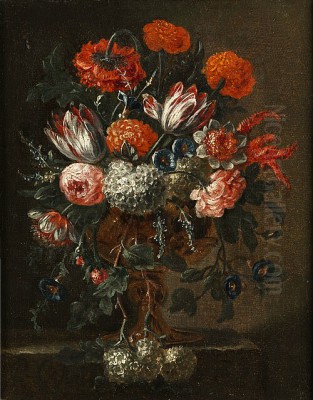
Pieter Casteels III stands as a significant figure in the transition of Flemish artistic traditions into the burgeoning art scene of early 18th-century England. Born into an artistic dynasty in Antwerp and later establishing a highly successful career in London, Casteels became renowned for his vibrant and meticulously detailed paintings of flowers and birds, subjects that perfectly suited the decorative tastes of the era. His work not only reflects the rich heritage of Netherlandish still life but also demonstrates a skillful adaptation to the demands and opportunities of his adopted homeland.
Antwerp Origins and Artistic Lineage
Pieter Casteels III entered the world in Antwerp in 1684. Artistry was embedded in his family background; his father, Pieter Casteels II, was himself a recognized painter, known primarily for landscapes and historical subjects. Growing up in this environment undoubtedly provided the young Pieter with early exposure to the techniques and traditions of Flemish painting. He received his initial artistic training directly from his father, learning the fundamentals of drawing and painting within the family workshop. This apprenticeship grounded him in the technical proficiency characteristic of Antwerp artists.
The artistic legacy of Antwerp during the 17th century, the era preceding Casteels's birth but whose influence lingered, was profound. Masters like Peter Paul Rubens and Anthony van Dyck had established the city as a major European art center. While Casteels III would specialize in different genres, the emphasis on rich color, dynamic composition, and technical skill, hallmarks of the Flemish Baroque, formed part of his artistic inheritance. His focus would eventually turn towards still life and animal painting, genres perfected by earlier Flemish artists such as Jan Brueghel the Elder, known as 'Velvet' Brueghel for his exquisite detail.
The Move to England and Early Career
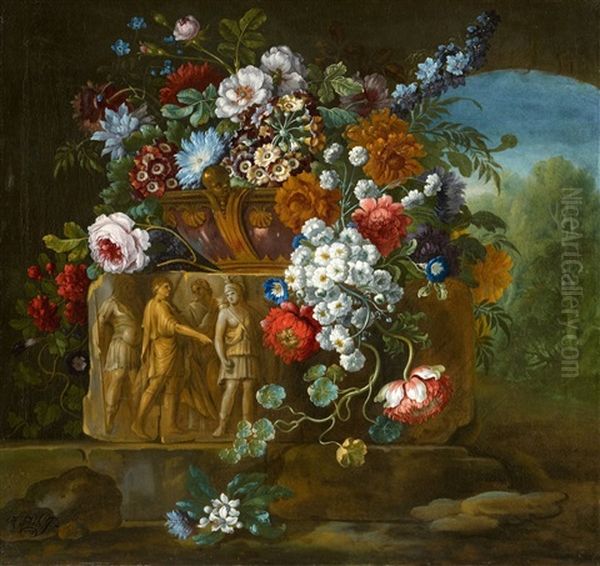
In 1708, seeking broader opportunities, Pieter Casteels III made the pivotal decision to move to England. London, at the time, was becoming an increasingly attractive center for artists, partly due to growing aristocratic and mercantile wealth and a corresponding demand for art, particularly decorative pieces for newly built or refurbished homes. Initially, like many immigrant artists, Casteels reportedly supported himself by copying the works of Old Masters, a common practice that allowed artists to hone their skills while familiarizing themselves with the tastes of potential patrons.
His talent did not go unnoticed for long. By 1711, Casteels had gained sufficient recognition to join the prestigious Kneller Academy of Painting and Drawing in London. Founded by Sir Godfrey Kneller, the leading portrait painter in England at the time, the academy was a hub for artistic training and networking. Membership signified a level of acceptance within the London art establishment. Casteels also became associated with the Rose and Crown Club, a convivial society frequented by artists, collectors, and connoisseurs, further integrating him into the city's artistic circles. After a brief return visit to Antwerp, he settled permanently in London around 1717, ready to establish his independent career.
Specialization in Flower Painting
Casteels III soon carved a niche for himself specializing in flower paintings. This genre had a long and distinguished history in the Low Countries, with artists like Jan Brueghel the Elder, Ambrosius Bosschaert the Elder, and later Jan van Huysum setting incredibly high standards. Casteels drew upon this tradition, creating compositions filled with a variety of blooms, often depicted with botanical accuracy yet arranged for maximum decorative effect. His flower pieces were characterized by their bright palettes, intricate detail, and often opulent feel.
These paintings were highly sought after for interior decoration. They frequently served specific architectural functions, designed as overdoors (paintings placed above doorways) or as part of chimneypiece ensembles. Their purpose was to bring the beauty and color of nature indoors, complementing the elegant furnishings of Georgian homes. Casteels competed in this market with other specialists, including immigrant French artists like Jean-Baptiste Monnoyer and his son Antoine Monnoyer, who were also highly regarded for their floral works in England. Casteels' Flemish training, however, perhaps lent his work a particular richness and solidity.
The Celebrated Twelve Months of Flowers
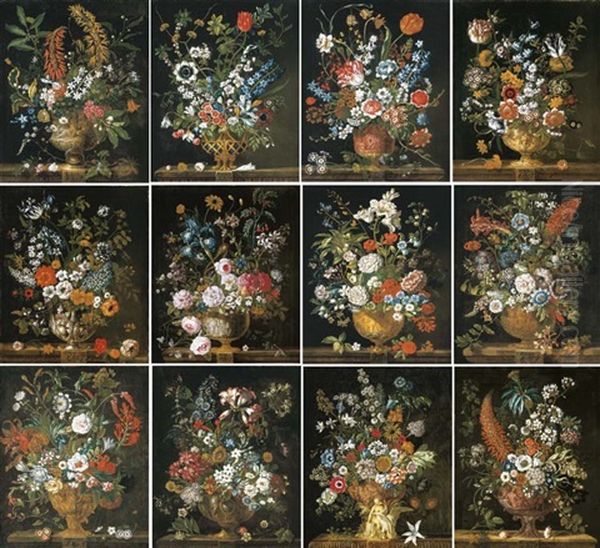
One of Casteels III's most significant and enduring contributions was his collaboration on the Twelve Months of Flowers. This ambitious project, published around 1730, was conceived by Robert Furber, a prominent nurseryman based in Kensington, then just outside London. Furber wished to create a lavish catalogue showcasing the wide variety of flowers available from his nursery throughout the year. He commissioned Casteels to design twelve intricate compositions, one for each month, featuring the flowers that bloomed during that period, carefully arranged in elaborate urns or baskets.
Casteels' designs were then translated into engravings, primarily by Henry Fletcher, and meticulously hand-coloured. The resulting prints were both scientifically informative, acting as a visual guide for gardeners and enthusiasts, and highly decorative works of art in their own right. The series was a tremendous success, appealing to the Georgian passion for gardening and natural history. It remains one of the most famous and visually stunning examples of 18th-century botanical illustration, cementing Casteels' reputation as a leading flower painter. The collaboration highlights the intersection of art, commerce, and science in this period.
Master of Avian Subjects
Alongside flowers, Pieter Casteels III developed a remarkable proficiency in depicting birds. His canvases often teem with life, featuring a diverse array of avian species, from common domestic fowl like chickens and pigeons to exotic birds such as peacocks, parrots, and waterfowl. These bird paintings, much like his floral works, were primarily decorative in intent, often set in idealized parkland or garden settings reminiscent of aristocratic estates. Works like the painting sometimes titled Flora exemplify this, showcasing various birds arranged harmoniously within a classical landscape.
His skill in capturing the distinct plumage, posture, and character of different birds was exceptional. This specialization tapped into another aspect of contemporary taste: the fascination with exotic animals and the establishment of menageries and aviaries on country estates. Casteels' paintings provided a permanent, idealized vision of this natural wealth. His work in this area invites comparison with earlier masters of bird painting like Melchior d'Hondecoeter from the Dutch Golden Age, whose dramatic poultry yard scenes were highly influential, and perhaps with Jakob Bogdani, another successful immigrant artist from Hungary working in England slightly earlier than Casteels, who also specialized in exotic birds and still life.
The Twelve Months of Fruits

Building on the success of the Twelve Months of Flowers, Casteels and Robert Furber collaborated again on a companion series, the Twelve Months of Fruits, published in 1732. Following the same format, Casteels designed twelve compositions, each representing a month and showcasing the fruits available during that time. Apples, pears, plums, grapes, cherries, melons, and more exotic fruits like pineapples (a symbol of luxury and horticultural achievement) were depicted in abundance, often arranged in baskets or piled attractively.
Like the flower series, these designs were engraved and hand-coloured, serving as both a catalogue for Furber's nursery and desirable decorative prints. This series further demonstrated Casteels' versatility within the still life genre and his ability to render different textures and forms with convincing realism and appealing composition. These print series were innovative marketing tools for Furber and provided Casteels with widespread visibility beyond the circles of those who could afford his original paintings.
Style, Technique, and Influences
Pieter Casteels III's style is characterized by meticulous attention to detail, a vibrant and often high-keyed colour palette, and strong compositional structure. He inherited the Flemish love for rendering textures accurately, whether the delicate petals of a flower, the iridescent sheen of a peacock's feather, or the downy softness of a chick. His arrangements, while appearing naturalistic, are carefully constructed for decorative balance and visual appeal. He often favoured abundant, overflowing compositions, particularly in his flower pieces, reflecting the Baroque taste for opulence.
His work clearly shows the influence of the Netherlandish still life tradition. The detailed naturalism harks back to Jan Brueghel the Elder, while the richness and compositional arrangements sometimes echo the work of artists like Cornelis de Heem. While primarily known for genre scenes, the meticulous detail found in some Dutch Golden Age painters like Pieter de Hooch might also be seen as part of the broader artistic context influencing the era's emphasis on careful observation, although De Hooch's subject matter was very different. Some sources also suggest a possible, though less direct, influence from the intricate compositions of the French engraver Jacques Callot, perhaps in the handling of complex groupings. Casteels successfully blended these influences into a style that was both traditional and perfectly suited to the tastes of his English clientele.
Notable Works and Range
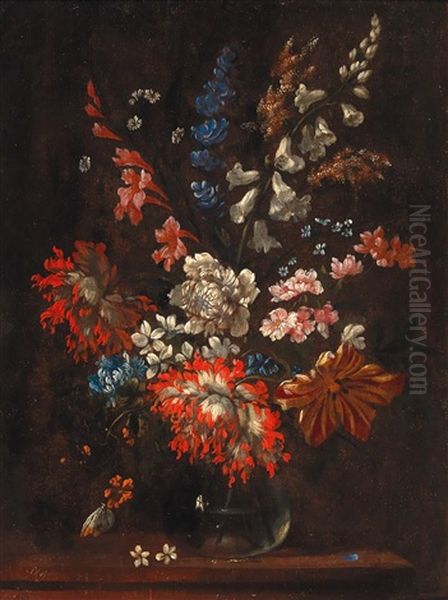
Beyond the famous print series, numerous individual paintings attest to Casteels III's skill and range. His Flower Still Life with a Fragment of a Roman Relief (1729) combines his floral expertise with an element of classical antiquity, a common feature in decorative schemes of the period. A study of birds and waterfowl (also dated 1729) showcases his specific focus on avian life, likely serving as both an independent work and potentially as a study for larger compositions.
Works like A Dutch Farm Scene (1720s), depicting chickens and chicks in a farmyard setting, show his ability to handle more rustic, though still idealized, subjects. The Fable of the Raven (from Aesop, c. 1723-1725) indicates an engagement with narrative or allegorical themes, although decorative still life remained his primary focus. These examples demonstrate his versatility within his chosen specializations, consistently applying his characteristic detailed finish and vibrant colour sense.
Context within the London Art World
Pieter Casteels III operated within a dynamic London art scene. While dominated by portraiture, led by figures like Sir Godfrey Kneller and later William Hogarth, there was a strong market for other genres. Landscape painting was gaining popularity, with artists like Peter Tillemans (who was related to Casteels, often cited as his brother-in-law) finding success. Decorative painting, including still life, animal painting, and topographical views, was in high demand for the interiors of townhouses and country estates.
Casteels was one of several talented immigrant artists who significantly enriched the British art scene during this period. Artists from the Low Countries, France, and Italy brought with them skills and traditions that were eagerly absorbed and adapted. Casteels' success lay in his ability to provide high-quality, decorative works in the esteemed Flemish tradition, perfectly meeting the demands of British patrons for art that signified taste, wealth, and an appreciation of nature's beauty. His membership in the Kneller Academy and the Rose and Crown Club placed him firmly within this professional network.
Later Life and Legacy
In his later years, Pieter Casteels III moved from the bustling center of London to the more tranquil surroundings of Richmond, then a fashionable semi-rural retreat favoured by artists and writers. He continued to paint, although information about his very last years is less detailed. He passed away in Richmond in 1749, having enjoyed a long and prosperous career spanning over four decades in England.
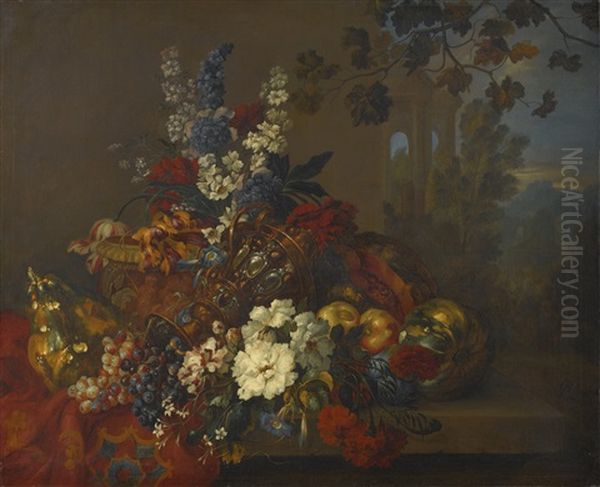
His legacy lies primarily in his contribution to the genres of flower and bird painting in England. He successfully transplanted the rich Flemish still life tradition onto English soil, adapting it to local tastes and decorative needs. His works, particularly the collaborative print series Twelve Months of Flowers and Twelve Months of Fruits, achieved wide circulation and lasting fame, influencing botanical illustration and decorative arts. His paintings remain admired for their technical skill, vibrant beauty, and as charming reflections of Georgian taste. Today, his works are held in numerous public and private collections, particularly in the United Kingdom, bearing witness to his significant role as a Flemish master working in 18th-century England. He remains an important figure for understanding the cross-cultural artistic exchanges that shaped British art.